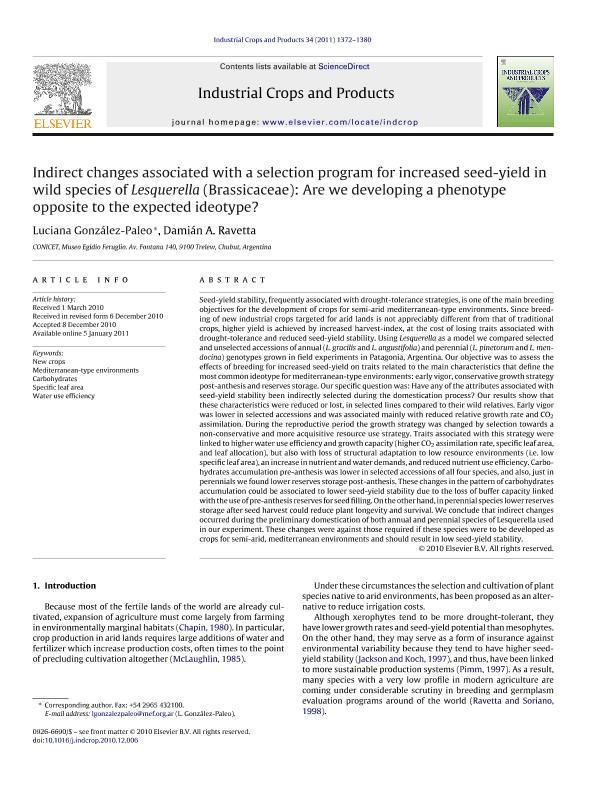Artículo
Indirect changes associated with a selection program for increased seed-yield in wild species of Lesquerella (Brassicaceae): Are we developing a phenotype opposite to the expected ideotype?
Fecha de publicación:
09/2011
Editorial:
Elsevier Science
Revista:
Industrial Crops and Products
ISSN:
0926-6690
Idioma:
Inglés
Tipo de recurso:
Artículo publicado
Clasificación temática:
Resumen
Seed-yield stability, frequently associated with drought-tolerance strategies, is one of the main breeding objectives for the development of crops for semi-arid mediterranean-type environments. Since breeding of new industrial crops targeted for arid lands is not appreciably different from that of traditional crops, higher yield is achieved by increased harvest-index, at the cost of losing traits associated with drought-tolerance and reduced seed-yield stability. Using Lesquerella as a model we compared selected and unselected accessions of annual (L. gracilis and L. angustifolia) and perennial (L. pinetorum and L. mendocina) genotypes grown in field experiments in Patagonia, Argentina. Our objective was to assess the effects of breeding for increased seed-yield on traits related to the main characteristics that define the most common ideotype for mediterranean-type environments: early vigor, conservative growth strategy post-anthesis and reserves storage. Our specific question was: Have any of the attributes associated with seed-yield stability been indirectly selected during the domestication process? Our results show that these characteristics were reduced or lost, in selected lines compared to their wild relatives. Early vigor was lower in selected accessions and was associated mainly with reduced relative growth rate and CO2 assimilation. During the reproductive period the growth strategy was changed by selection towards a non-conservative and more acquisitive resource use strategy. Traits associated with this strategy were linked to higher water use efficiency and growth capacity (higher CO2 assimilation rate, specific leaf area, and leaf allocation), but also with loss of structural adaptation to low resource environments (i.e. low specific leaf area), an increase in nutrient and water demands, and reduced nutrient use efficiency. Carbohydrates accumulation pre-anthesis was lower in selected accessions of all four species, and also, just in perennials we found lower reserves storage post-anthesis. These changes in the pattern of carbohydrates accumulation could be associated to lower seed-yield stability due to the loss of buffer capacity linked with the use of pre-anthesis reserves for seed filling. On the other hand, in perennial species lower reserves storage after seed harvest could reduce plant longevity and survival. We conclude that indirect changes occurred during the preliminary domestication of both annual and perennial species of Lesquerella used in our experiment. These changes were against those required if these species were to be developed as crops for semi-arid, mediterranean environments and should result in low seed-yield stability.
Archivos asociados
Licencia
Identificadores
Colecciones
Articulos(SEDE CENTRAL)
Articulos de SEDE CENTRAL
Articulos de SEDE CENTRAL
Citación
González Paleo, Luciana; Ravetta, Damián Andrés; Indirect changes associated with a selection program for increased seed-yield in wild species of Lesquerella (Brassicaceae): Are we developing a phenotype opposite to the expected ideotype?; Elsevier Science; Industrial Crops and Products; 34; 2; 9-2011; 1372-1380
Compartir
Altmétricas




